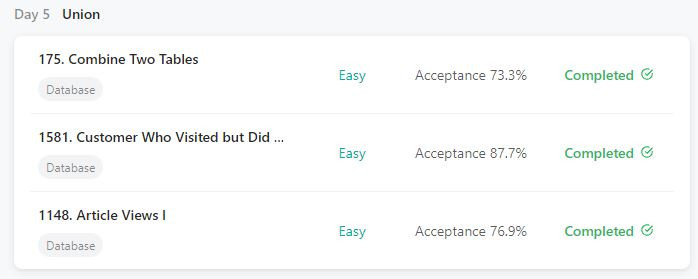昨天在看魔笛最後一舞~今天多刷一點題,晚上看能不能看到梅西封王,
會不會也是2:1呢??![]()

+-------------+---------+
| Column Name | Type |
+-------------+---------+
| personId | int |
| lastName | varchar |
| firstName | varchar |
+-------------+---------+
personId is the primary key column for this table.
This table contains information about the ID of some persons and their first and last names.
Table: Address
+-------------+---------+
| Column Name | Type |
+-------------+---------+
| addressId | int |
| personId | int |
| city | varchar |
| state | varchar |
+-------------+---------+
addressId is the primary key column for this table.
Each row of this table contains information about the city and state of one person with ID = PersonId.
Write an SQL query to report the first name, last name, city, and state of each person in the Person table. If the address of a personId is not present in the Address table, report null instead.
Return the result table in any order.
The query result format is in the following example.
Example 1:
Input:
Person table:
+----------+----------+-----------+
| personId | lastName | firstName |
+----------+----------+-----------+
| 1 | Wang | Allen |
| 2 | Alice | Bob |
+----------+----------+-----------+
Address table:
+-----------+----------+---------------+------------+
| addressId | personId | city | state |
+-----------+----------+---------------+------------+
| 1 | 2 | New York City | New York |
| 2 | 3 | Leetcode | California |
+-----------+----------+---------------+------------+
Output:
+-----------+----------+---------------+----------+
| firstName | lastName | city | state |
+-----------+----------+---------------+----------+
| Allen | Wang | Null | Null |
| Bob | Alice | New York City | New York |
+-----------+----------+---------------+----------+
Explanation:
There is no address in the address table for the personId = 1 so we return null in their city and state.
addressId = 1 contains information about the address of personId = 2.
這一題要我們連結兩個表,從city、state中看到null值,
就知道要用join把Address的資料加到Person中,
比較笨的是一度寫成JOIN LEFT,導致錯誤,最後在w3s中找到LEFT JOIN來使用
SELECT firstName, lastName, city,state FROM Person
LEFT JOIN Address ON Person.PersonId = Address.PersonId;
+-------------+---------+
| Column Name | Type |
+-------------+---------+
| visit_id | int |
| customer_id | int |
+-------------+---------+
visit_id is the primary key for this table.
This table contains information about the customers who visited the mall.
Table: Transactions
+----------------+---------+
| Column Name | Type |
+----------------+---------+
| transaction_id | int |
| visit_id | int |
| amount | int |
+----------------+---------+
transaction_id is the primary key for this table.
This table contains information about the transactions made during the visit_id.
Write an SQL query to find the IDs of the users who visited without making any transactions and the number of times they made these types of visits.
Return the result table sorted in any order.
The query result format is in the following example.
Example 1:
Input:
Visits
+----------+-------------+
| visit_id | customer_id |
+----------+-------------+
| 1 | 23 |
| 2 | 9 |
| 4 | 30 |
| 5 | 54 |
| 6 | 96 |
| 7 | 54 |
| 8 | 54 |
+----------+-------------+
Transactions
+----------------+----------+--------+
| transaction_id | visit_id | amount |
+----------------+----------+--------+
| 2 | 5 | 310 |
| 3 | 5 | 300 |
| 9 | 5 | 200 |
| 12 | 1 | 910 |
| 13 | 2 | 970 |
+----------------+----------+--------+
Output:
+-------------+----------------+
| customer_id | count_no_trans |
+-------------+----------------+
| 54 | 2 |
| 30 | 1 |
| 96 | 1 |
+-------------+----------------+
Explanation:
Customer with id = 23 visited the mall once and made one transaction during the visit with id = 12.
Customer with id = 9 visited the mall once and made one transaction during the visit with id = 13.
Customer with id = 30 visited the mall once and did not make any transactions.
Customer with id = 54 visited the mall three times. During 2 visits they did not make any transactions, and during one visit they made 3 transactions.
Customer with id = 96 visited the mall once and did not make any transactions.
As we can see, users with IDs 30 and 96 visited the mall one time without making any transactions. Also, user 54 visited the mall twice and did not make any transactions.
這題比較多程序,題目要我們列出來店裡卻沒購買的客人記錄,我的思路是這樣:
1.列出visit_id中4.6.7.8 這些是沒有購買的記錄
把Transactions.visit_id加到Visits.visit_id中再去找NULL值
2.統計次數,重複的加總在一起
加總COUNT(Visits.visit_id),用SUM()的加總意義會不一樣
最後記得要用GROUP BY而不是ORDER BY。
SELECT Visits.customer_id ,COUNT(Visits.visit_id) AS count_no_trans
FROM Visits
LEFT JOIN Transactions ON Visits.visit_id = Transactions.visit_id
WHERE Transactions.visit_id IS NULL
GROUP BY customer_id;
+---------------+---------+
| Column Name | Type |
+---------------+---------+
| article_id | int |
| author_id | int |
| viewer_id | int |
| view_date | date |
+---------------+---------+
There is no primary key for this table, it may have duplicate rows.
Each row of this table indicates that some viewer viewed an article (written by some author) on some date.
Note that equal author_id and viewer_id indicate the same person.
Write an SQL query to find all the authors that viewed at least one of their own articles.
Return the result table sorted by id in ascending order.
The query result format is in the following example.
Example 1:
Input:
Views table:
+------------+-----------+-----------+------------+
| article_id | author_id | viewer_id | view_date |
+------------+-----------+-----------+------------+
| 1 | 3 | 5 | 2019-08-01 |
| 1 | 3 | 6 | 2019-08-02 |
| 2 | 7 | 7 | 2019-08-01 |
| 2 | 7 | 6 | 2019-08-02 |
| 4 | 7 | 1 | 2019-07-22 |
| 3 | 4 | 4 | 2019-07-21 |
| 3 | 4 | 4 | 2019-07-21 |
+------------+-----------+-----------+------------+
Output:
+------+
| id |
+------+
| 4 |
| 7 |
+------+
article_id文章| author_id作者 | viewer_id閱覽者,
這題要找出有查看自己文章的作者,從表上能看到4跟7兩位都有這個記錄,
只要找出author_id作者=viewer_id閱覽者的值並去掉重複值(DISTINCT),
就能找到答案了,最後別忘了ORDER BY 排序一下。
SELECT DISTINCT author_id AS id
FROM Views V
WHERE V.author_id = V.viewer_id
ORDER BY id
